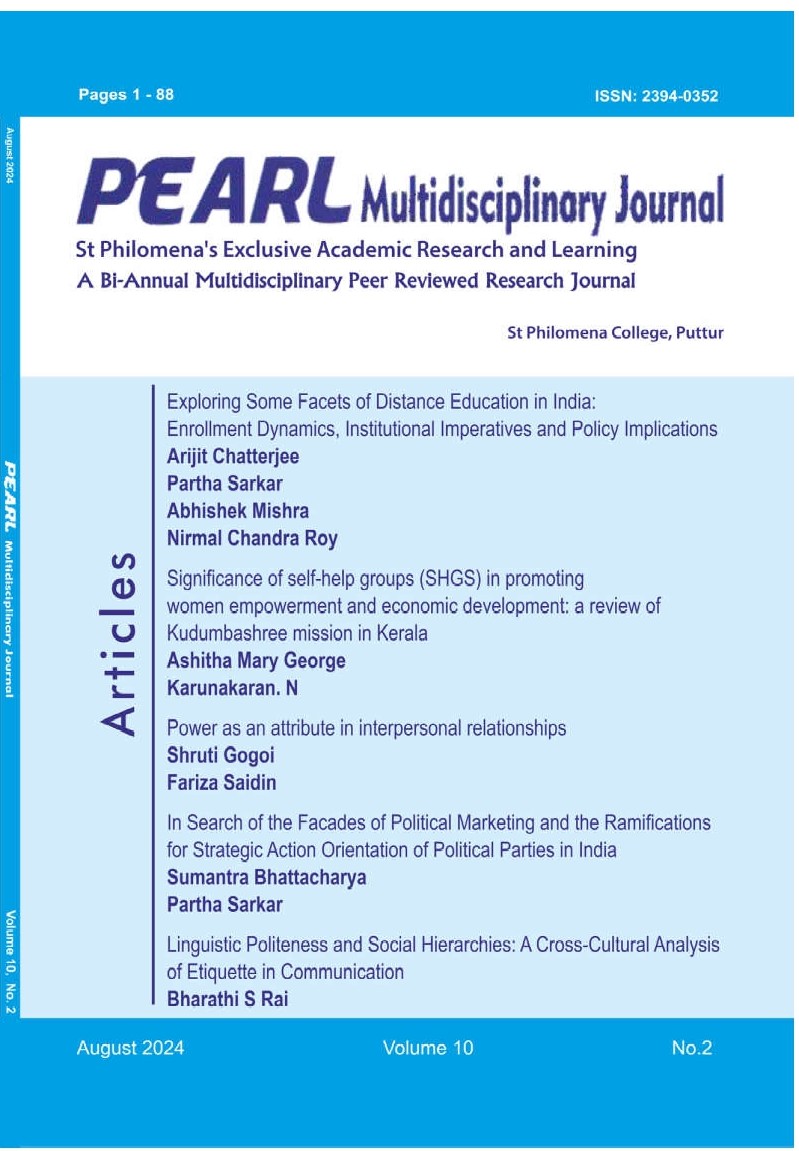
Parents of Children with Intellectual Developmental Disorder (IDD): A Study of Informal Caregivers in Kerala and Maharashtra
Power as an Attribute in Interpersonal Relationships
Exploring Some Facets of Distance Education in India: Enrollment Dynamics, Institutional Imperatives and Policy Implications
Extent of Underemployment among Government Service Employees in Kerala
Underemployment in the public sector is defined as a situation in which government employees are employed below their education or skill level, or their availability. It is a social problem that affects job growth, career growth and the emotional health of underemployed workers. The study checked the extent of underemployment among Kerala government service employees in the context of their education, age and gender wise analysis. The result revealed that age matters in the perception of employees on underemployment and is negatively related to underemployment. In the case of lower age people, they consider them as underemployed while aged people do not bother about it. Gender and qualification do not play a role in the employee’s perception of feeling on underemployment.
Health, Safety and Welfare Schemes in Association with Job Contracts and Training among Migrant Construction Workers in Gurgaon, India
Post pandemic reimmigration of unorganised construction workers in India too witnessed various ups and downs like other nations. The survey conducted by an NGO in Gurgaon, Haryana state, India highlights health, safety, sanitation, and welfare schemes in association with job contracts and training programs. Quantitative and qualitative analysis of the primary data shows inadequate training programs leading to health and safety hazards among migrant construction workers in the study area. Although half of the work force is satisfied with the working conditions, hardly any of them are registered in any government welfare schemes like e-shram which is designed for unorganised migrant workers in India. The study indicates a dire need for training programs, particularly in the safety and health fields, and recommends focusing on the welfare of the unorganised workers, considering them on par with any other work force in the country who contributes to the GDP (Gross domestic product) of the nation.
Dynamics of Thoron Concentration in Dwellings of the Industrial Sites in Kannur District, Kerala
The current study deals with the evaluation of the indoor concentration of 220Rn (thoron) in different dwellings with various construction materials used for the roof and floor in the major industrial sites of Kannur district, Kerala. A pinhole-based dosimeter coupled with LR-115 Solid State Nuclear Track Detector (SSNTD) and Direct Thoron Progeny Sensor (DTPS) were respectively used for the measurement of indoor concentration and equilibrium equivalent concentration of thoron. The thoron concentrations were found to vary from 124.64 Bqm-3 - 453.65 Bqm-3. The annual effective doses and excess lifetime cancer risks were observed in the range of 3.144 mSvy-1 -11.4 mSvy-1 and 13x10-3 to 45x10-3 respectively, and both exceeded the world average values recommended by UNSCEAR 2000. The study shows that, the houses with marble floor and concrete roof have comparatively higher values of thoron concentration, which indicates the significant contribution of construction materials to the enhanced radiation levels inside the dwellings.
Factors Affecting Suicidal Ideation in Adolescents in the Context of Perceived Stress and Peer Pressure
Suicide is a major concern for all age groups nowadays. It is a serious problem that can cause a lot of distress in one’s life. It has been an adverse cause of death worldwide, so to see the aetiology of suicide among adolescents; a survey was conducted on 150 school students, age group of 10-19 years, consisting of both males and females. This study was done in order to understand the underlying factors of suicidal ideation in them. The factors taken into consideration were peer pressure and perceived stress. The scales used for the survey are Perceived Stress Scale, Peer Pressure Inventory and Suicidal Ideation Scale. The set hypothesis states that there is a correlation among perceived stress, peer pressure and suicidal ideation. The findings demonstrated that perceived stress has a correlation with suicidal ideation and that an increase in perceived stress causes vulnerability to suicidal ideation. The finding also stated that there is a significant correlation between suicidal ideation and misconduct, which is the domain of peer pressure. Thus, it proves that school students get vulnerable with increase in peer pressure and perceived stress which causes a vulnerability to suicidal ideation.
Indian Banking: The Post Covid-19 Scenario
Covid-19 hit us suddenly and unexpectedly. It spread far and wide very quickly. The world was not prepared for it, and neither were the businesses. Prolonged lockdowns brought the economy to a standstill. Though it is not a banking crisis as such, it naturally affected the banks. Banks, being the forerunners of the economy, had to think fast and undertake major changes to carry on with their businesses and the services that they provide. This meant certain changes to the systems and procedures that were being normally followed. In order to support the sudden changes, technology adaptation was fast paced and technology solution providers came into the picture. The change that was going on at a certain pace was accelerated. The customers also had to somewhat begin adapting to these new modes of banking experience. The competition has now begun in the technological dynamism, amongst the banks. Will these changes be long lasting or will we return to pre pandemic era of banking, is for the future to tell? The changes are dynamic and, at the present moment looks like they are here to stay. This article looks into the changes that have been inflicted upon the banking industry in India due to Covid-19, and what probable changes are here to stay.
An Analysis of Road Dust Samples to Understand the Influence of Vehicle Density on the Heavy Metal Accumulation in Kannur District, Kerala, India
The present study is an attempt to assess the heavy metal buildup in road dust samples of heavy traffic areas of Narath Panchayath, Kannur district. Samples have been collected from the roadside and are analyzed using X-Ray Fluorescence (XRF) spectroscopy technique. The study also deals with health effects associated with heavy metal accumulation in the study area by calculating and interpreting the various hazard index parameters such as contamination factor, enrichment factor, geo-accumulation index, pollution load index, and degree of contamination. The concentration of heavy metals such as Fe, Co, Ni, Cu, Zn, As, Cd, and Pb has been quantified and reported in the ppb units. It is observed that the study area has a specific higher concentration of Fe and a lower concentration of Cd. The index parameters were calculated from the observed concentration of heavy metals and thereby pollution rate is understood. The study indicates that the metallic dust emitted from the vehicles significantly contributed to the heavy metal concentration in the area. The buildup of heavy metals is also influenced by traffic density, weather conditions, and human and industrial activities in that area. The detailed results and discussion of the present systematic investigation are given in the manuscript.
Social Anxiety as a Function of Shyness and Locus of Control
In adolescence many children experience social anxiety in new social situations where they always try to avoid crowd. They always worry doing something they think is embarrassing such as blushing, sweating or appearing incompetent. They also find it difficult to do things when others are watching because they might feel they are being watched and judged all the time, fear of being criticized or have low self-esteem. Shyness is common which refers to feeling uncomfortable in social situations. If someone feels shy, still can motivate themselves to perform the work required. But someone with social anxiety can affect someone’s quality of life. And locus of control refers to the extent to which individuals believe they can control events affecting them. This study was done to investigate how social anxiety correlates with shyness and locus of control among the adolescence. Comparative study was done and the results show that there is correlation between shyness and locus of control but no significant correlation between social anxiety and locus of control.
Have a paper to submit?
Submit right here and we’ll let you know when it’s been approved
Submit Paper


